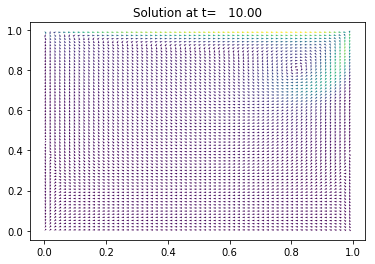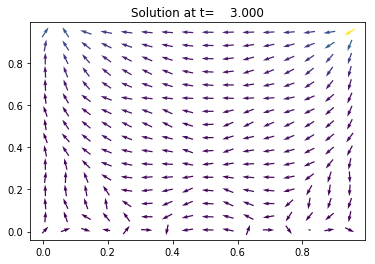Lid driven cavity¶
In this tutorial, we consider the classical \(\DdQq{2}{9}\) and \(\DdQq{3}{15}\) to simulate a lid driven acvity modeling by the Navier-Stokes equations. The \(\DdQq{2}{9}\) is used in dimension \(2\) and the \(\DdQq{3}{15}\) in dimension \(3\).
[1]:
%matplotlib inline
The \(\DdQq{2}{9}\) for Navier-Stokes¶
The \(\DdQq{2}{9}\) is defined by:
a space step \(\dx\) and a time step \(\dt\) related to the scheme velocity \(\lambda\) by the relation \(\lambda=\dx/\dt\),
nine velocities \(\{(0,0), (\pm1,0), (0,\pm1), (\pm1, \pm1)\}\), identified in pylbm by the numbers \(0\) to \(8\),
nine polynomials used to build the moments
where \(E = X^2+Y^2\).
three conserved moments \(\rho\), \(q_x\), and \(q_y\),
nine relaxation parameters (three are \(0\) corresponding to conserved moments): \(\{0,0,0,s_\mu,s_\mu,s_\eta,s_\eta,s_\eta,s_\eta\}\), where \(s_\mu\) and \(s_\eta\) are in \((0,2)\),
equilibrium value of the non conserved moments
where \(\rho_0\) is a given scalar.
This scheme is consistant at second order with the following equations (taken \(\rho_0=1\))
with \(p=\rho\lambda^2/3\).
We write the dictionary for a simulation of the Navier-Stokes equations on \((0,1)^2\).
In order to impose the boundary conditions, we use the bounce-back conditions to fix \(q_x=q_y=0\) at south, east, and west and \(q_x=\rho u\), \(q_y=0\) at north. The driven velocity \(u\) could be \(u=\lambda/10\).
The solution is governed by the Reynolds number \(Re = \rho_0u / \eta\). We fix the relaxation parameters to have \(Re=1000\). The relaxation parameters related to the bulk viscosity \(\mu\) should be large enough to ensure the stability (for instance \(\mu=10^{-3}\)).
We compute the stationary solution of the problem obtained for large enough final time. We plot the solution with the function quiver of matplotlib.
[2]:
import numpy as np
import sympy as sp
import matplotlib.pyplot as plt
import pylbm
X, Y, LA = sp.symbols('X, Y, LA')
rho, qx, qy = sp.symbols('rho, qx, qy')
def bc(f, m, x, y):
m[qx] = rhoo * vup
def plot(sol):
pas = 2
y, x = np.meshgrid(sol.domain.y[::pas], sol.domain.x[::pas])
u = sol.m[qx][::pas,::pas] / sol.m[rho][::pas,::pas]
v = sol.m[qy][::pas,::pas] / sol.m[rho][::pas,::pas]
nv = np.sqrt(u**2+v**2)
normu = nv.max()
u = u / (nv+1e-5)
v = v / (nv+1e-5)
plt.quiver(x, y, u, v, nv, pivot='mid')
plt.title('Solution at t={0:8.2f}'.format(sol.t))
plt.show()
# parameters
Re = 1000
dx = 1./128 # spatial step
la = 1. # velocity of the scheme
Tf = 10 # final time of the simulation
vup = la/5 # maximal velocity obtained in the middle of the channel
rhoo = 1. # mean value of the density
mu = 1.e-4 # bulk viscosity
eta = rhoo*vup/Re # shear viscosity
# initialization
xmin, xmax, ymin, ymax = 0., 1., 0., 1.
dummy = 3.0/(la*rhoo*dx)
s_mu = 1.0/(0.5+mu*dummy)
s_eta = 1.0/(0.5+eta*dummy)
s_q = s_eta
s_es = s_mu
s = [0.,0.,0.,s_mu,s_es,s_q,s_q,s_eta,s_eta]
dummy = 1./(LA**2*rhoo)
qx2 = dummy*qx**2
qy2 = dummy*qy**2
q2 = qx2+qy2
qxy = dummy*qx*qy
print("Reynolds number: {0:10.3e}".format(Re))
print("Bulk viscosity : {0:10.3e}".format(mu))
print("Shear viscosity: {0:10.3e}".format(eta))
print("relaxation parameters: {0}".format(s))
dico = {
'box': {'x': [xmin, xmax],
'y': [ymin, ymax],
'label': [0, 0, 0, 1]
},
'space_step': dx,
'scheme_velocity': la,
'parameters': {LA: la},
'schemes': [
{
'velocities': list(range(9)),
'conserved_moments': [rho, qx, qy],
'polynomials': [
1, LA*X, LA*Y,
3*(X**2+Y**2)-4,
0.5*(9*(X**2+Y**2)**2-21*(X**2+Y**2)+8),
3*X*(X**2+Y**2)-5*X, 3*Y*(X**2+Y**2)-5*Y,
X**2-Y**2, X*Y
],
'relaxation_parameters': s,
'equilibrium': [
rho, qx, qy,
-2*rho + 3*q2,
rho-3*q2,
-qx/LA, -qy/LA,
qx2-qy2, qxy
],
},
],
'init': {rho: rhoo,
qx:0.,
qy:0.
},
'boundary_conditions': {
0: {'method': {0: pylbm.bc.BouzidiBounceBack}},
1: {'method': {0: pylbm.bc.BouzidiBounceBack}, 'value': bc}
},
'generator': 'cython',
}
sol = pylbm.Simulation(dico)
while (sol.t<Tf):
sol.one_time_step()
plot(sol)
Reynolds number: 1.000e+03
Bulk viscosity : 1.000e-04
Shear viscosity: 2.000e-04
relaxation parameters: [0.0, 0.0, 0.0, 1.8573551263001487, 1.8573551263001487, 1.7337031900138697, 1.7337031900138697, 1.7337031900138697, 1.7337031900138697]

The \(\DdQq{3}{15}\) for Navier-Stokes¶
The \(\DdQq{3}{15}\) is defined by:
a space step \(\dx\) and a time step \(\dt\) related to the scheme velocity \(\lambda\) by the relation \(\lambda=\dx/\dt\),
fifteen velocities \(\{(0,0,0), (\pm1,0,0), (0,\pm1,0), (0,0,\pm1), (\pm1, \pm1,\pm1)\}\), identified in pylbm by the numbers \(\{0,\ldots,6,19,\ldots,26\}\),
fifteen polynomials used to build the moments
where \(E = X^2+Y^2+Z^2\).
four conserved moments \(\rho\), \(q_x\), \(q_y\), and \(q_z\),
fifteen relaxation parameters (four are \(0\) corresponding to conserved moments): \(\{0, s_1, s_2, 0, s_4, 0, s_4, 0, s_4, s_9, s_9, s_{11}, s_{11}, s_{11}, s_{14}\}\),
equilibrium value of the non conserved moments
This scheme is consistant at second order with the Navier-Stokes equations with the shear viscosity \(\eta\) and the relaxation parameter \(s_9\) linked by the relation
We write a dictionary for a simulation of the Navier-Stokes equations on \((0,1)^3\).
In order to impose the boundary conditions, we use the bounce-back conditions to fix \(q_x=q_y=q_z=0\) at south, north, east, west, and bottom and \(q_x=\rho u\), \(q_y=q_z=0\) at top. The driven velocity \(u\) could be \(u=\lambda/10\).
We compute the stationary solution of the problem obtained for large enough final time. We plot the solution with the function quiver of matplotlib.
[3]:
X, Y, Z, LA = sp.symbols('X, Y, Z, LA')
rho, qx, qy, qz = sp.symbols('rho, qx, qy, qz')
def bc(f, m, x, y, z):
m[qx] = rhoo * vup
def plot(sol):
plt.clf()
pas = 4
nz = int(sol.domain.shape_in[1] / 2) + 1
y, x = np.meshgrid(sol.domain.y[::pas], sol.domain.x[::pas])
u = sol.m[qx][::pas,nz,::pas] / sol.m[rho][::pas,nz,::pas]
v = sol.m[qz][::pas,nz,::pas] / sol.m[rho][::pas,nz,::pas]
nv = np.sqrt(u**2+v**2)
normu = nv.max()
u = u / (nv+1e-5)
v = v / (nv+1e-5)
plt.quiver(x, y, u, v, nv, pivot='mid')
plt.title('Solution at t={0:9.3f}'.format(sol.t))
plt.show()
# parameters
Re = 2000
dx = 1./64 # spatial step
la = 1. # velocity of the scheme
Tf = 3 # final time of the simulation
vup = la/10 # maximal velocity obtained in the middle of the channel
rhoo = 1. # mean value of the density
eta = rhoo*vup/Re # shear viscosity
# initialization
xmin, xmax, ymin, ymax, zmin, zmax = 0., 1., 0., 1., 0., 1.
dummy = 3.0/(la*rhoo*dx)
s1 = 1.6
s2 = 1.2
s4 = 1.6
s9 = 1./(.5+dummy*eta)
s11 = s9
s14 = 1.2
s = [0, s1, s2, 0, s4, 0, s4, 0, s4, s9, s9, s11, s11, s11, s14]
r = X**2+Y**2+Z**2
print("Reynolds number: {0:10.3e}".format(Re))
print("Shear viscosity: {0:10.3e}".format(eta))
dico = {
'box':{
'x': [xmin, xmax],
'y': [ymin, ymax],
'z': [zmin, zmax],
'label': [0, 0, 0, 0, 0, 1]
},
'space_step': dx,
'scheme_velocity': la,
'parameters': {LA: la},
'schemes': [
{
'velocities': list(range(7)) + list(range(19,27)),
'conserved_moments': [rho, qx, qy, qz],
'polynomials': [
1,
r - 2, .5*(15*r**2-55*r+32),
X, .5*(5*r-13)*X,
Y, .5*(5*r-13)*Y,
Z, .5*(5*r-13)*Z,
3*X**2-r, Y**2-Z**2,
X*Y, Y*Z, Z*X,
X*Y*Z
],
'relaxation_parameters': s,
'equilibrium': [
rho,
-rho + qx**2 + qy**2 + qz**2,
-rho,
qx,
-7./3*qx,
qy,
-7./3*qy,
qz,
-7./3*qz,
1./3*(2*qx**2-(qy**2+qz**2)),
qy**2-qz**2,
qx*qy,
qy*qz,
qz*qx,
0
],
},
],
'init': {rho: rhoo,
qx: 0.,
qy: 0.,
qz: 0.
},
'boundary_conditions':{
0: {'method': {0: pylbm.bc.BouzidiBounceBack}},
1: {'method': {0: pylbm.bc.BouzidiBounceBack}, 'value': bc}
},
'generator': 'cython',
}
sol = pylbm.Simulation(dico)
while (sol.t<Tf):
sol.one_time_step()
plot(sol)
Reynolds number: 2.000e+03
Shear viscosity: 5.000e-05
[0] WARNING pylbm.scheme in function _check_inverse line 394
Problem M * invM is not identity !!!

[ ]:
